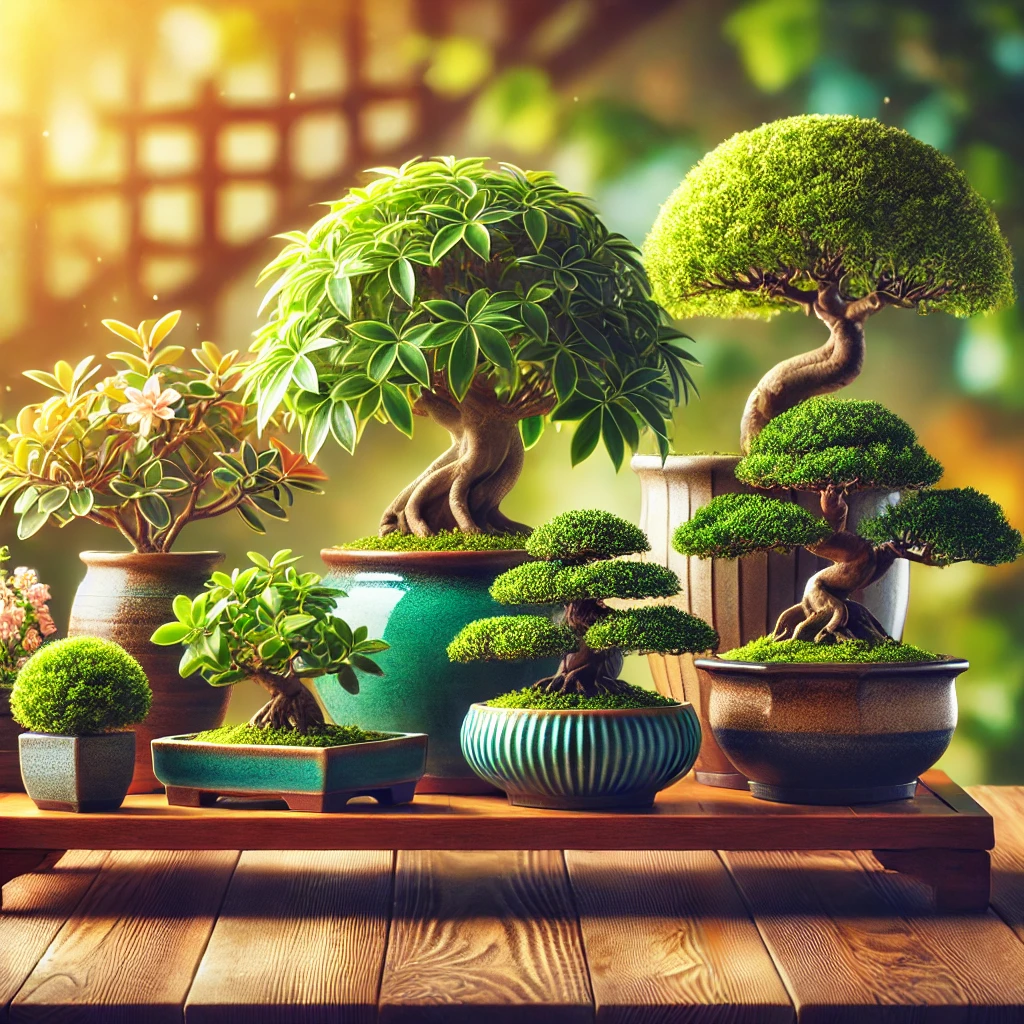Indoor plants come with a lot of benefits, they can purify the air, reduce stress and add a touch of nature to any place. The window plant has the added advantage of receiving natural light, which is essential for its growth and survival.
In India, with its tropical climate, there is a wide variety of window plants that can thrive in the Indian environment. In this article, I will walk you through the top 15 window plants that are perfect for Indian homes. From easy-to-care plants to elegant-looking plants these plants are sure to be a good choice for windowsills.
As an added bonus, I will also discuss their care requirements, and decorating ideas to help you choose the perfect plant for a window.
Best window plant to grow on your room windowsill
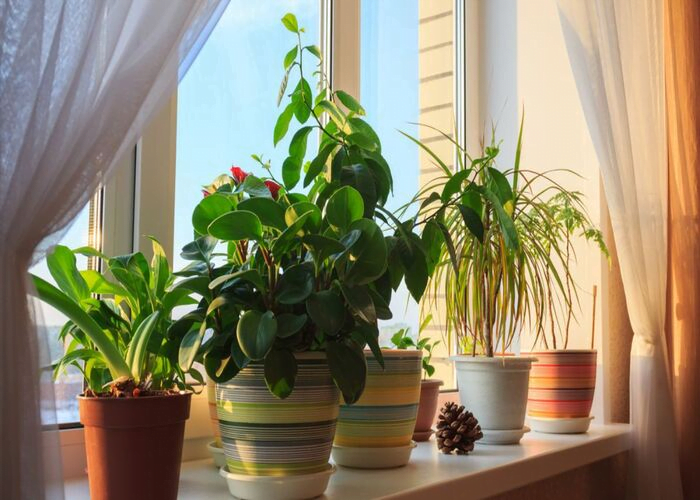
With this list, you will find the perfect plant for every window in your home. It doesn’t matter whether your window receives an abundance of light or a low amount of light, this list has you covered.
So, let’s take a look at some amazing plants that can be grown on windowsills.
1. Snake Plant
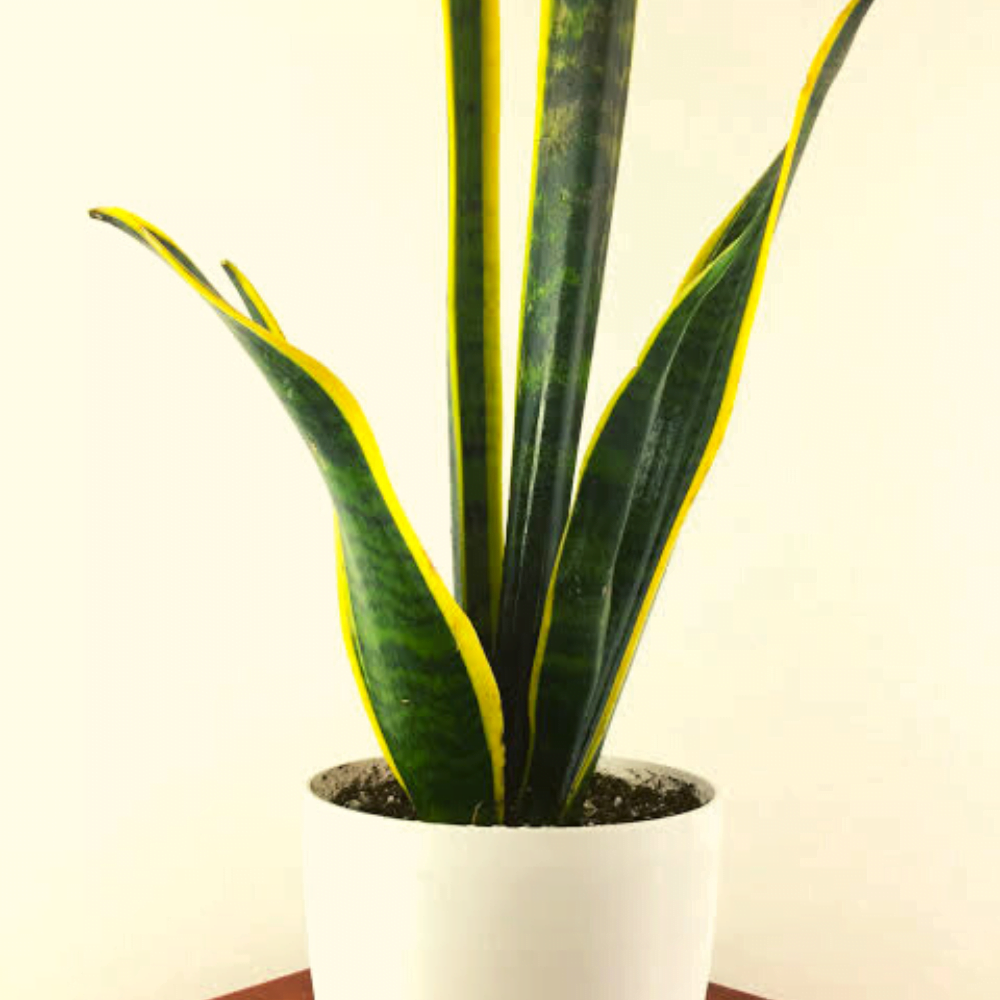
The sword like leaves of snake plants makes them stand out among other plants. Also, the best thing about snake plants is that you can grow them in any environment. West or south windows are best for keeping snake plants flourishing.
2. Spider Plant

On the spider plant’s leaves, there is a white stripe running along the center. A mature plant is usually displayed high or in a hanging basket to show the numerous plantlets and spider babies. In spring and summer, keep them about 12 inches (30 cm) away from south-facing windows. North-facing windows are fine too.
3. Pothos

As well as adding beauty to any room, this plant also purifies the air and minimizes bad odors. Low maintenance makes this vine ideal for growing anywhere. If you want to see it dangling down stylishly, plant it on a window or hanging basket.
4. Aloe vera

Aloe vera’s shape and flesh set it apart from other plants. Since aloe vera loves bright, direct light, you will absolutely love having one on your windowsill. South-facing windowsills work best for aloe vera, but west and east-facing windows work as well.
5. Money plant
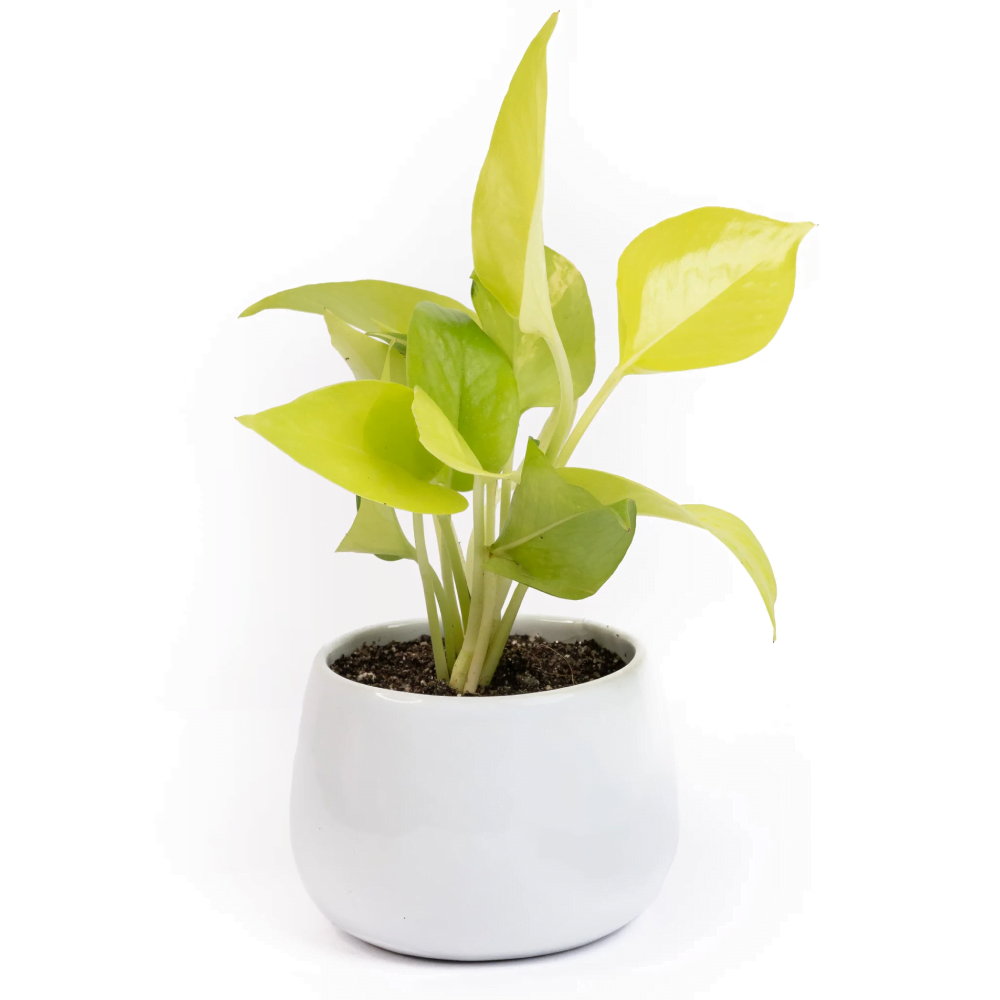
Dry conditions don’t bother the money plant. A dark green, heart-shaped leaf makes it stand out. On an uplifted stool, a plant with falling foliage will make your interiors look classic. Bright, indirect light is best for it, and it grows best near windows facing north or south.
6. Chinese Money Plant

Like coins, the leaves of this plant are shiny and round. For this reason, these plants are said to attract fortune and wealth. In addition, it’s low maintenance. Keep it close to a southeast-facing window to eliminate negative energy.
7. ZZ plant

It forms a graceful wand as it grows from a bulbous base to a point. This plant looks like a stylized feather due to its fleshy, oval-shaped leaves. The shiny, waxy coating on their leaves makes people mistake them for artificial ones. For ZZ plants, indirect light from north, east, or west-facing windows is best.
8. Ficus Benjamina

Your windowsill will look classy with Ficus Benjamina’s glossy, dark green leaves. It’s also very easy to take care of this window plant. Just make sure it’s placed in a bright but not directly exposed area.
9. Succulent

If you live in a dry or sunny environment, succulents are a great choice. This type of plant requires little care. It only needs indirect light and well-draining soil. For windowsills, grow aloes, agaves, echeverias, and crassulas, which are all low-growing and tolerate a range of light levels.
10. Boston Fern

Boston ferns look great on windows with their soft fronds and lush foliage. Make sure they receive bright, indirect light by placing them on a windowsill. To show off their cascading fronds, group Boston ferns with other plants or place them on a windowsill.
11. Peperomia
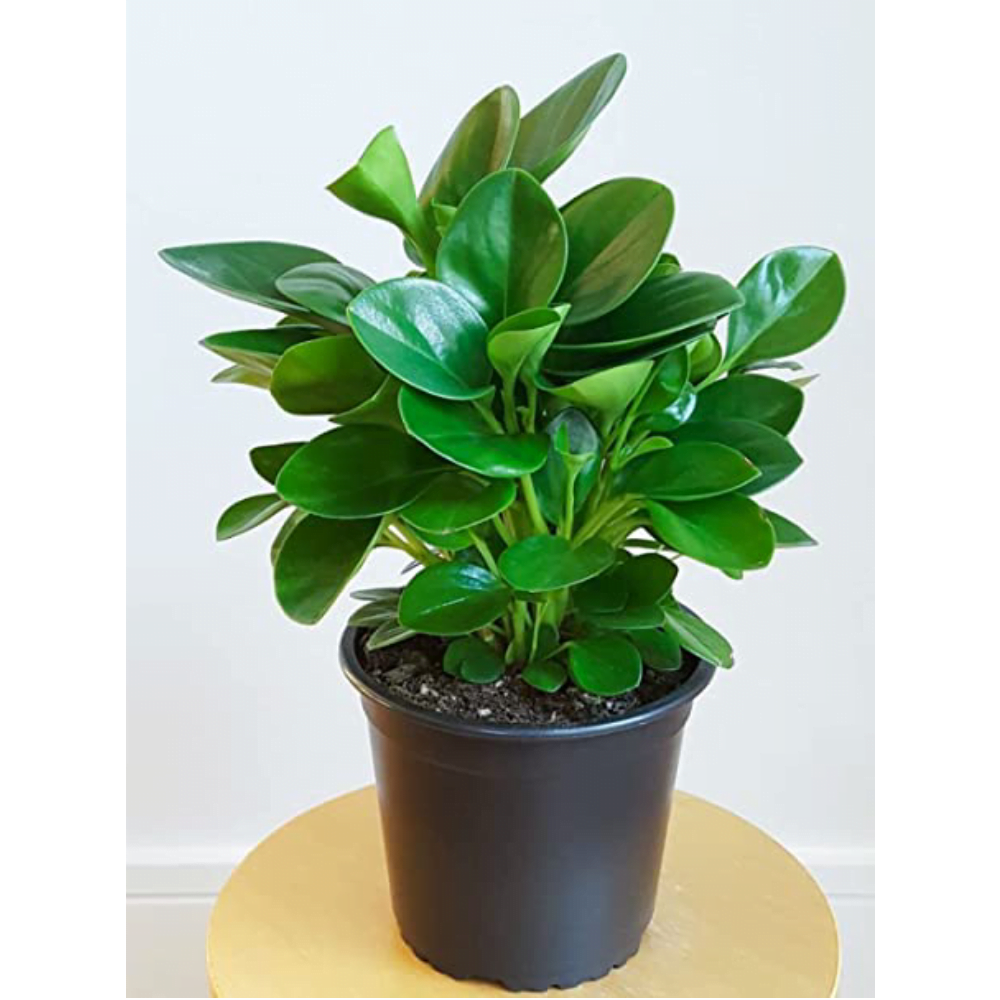
Its striped, round, pointed, and silvery leaves look like the rind of a watermelon. As they prefer indirect light, peperomias grow near east- or west-facing windows. It does well in rooms with north-facing windows, which have low light levels. Also, fluorescent lights can be used for peperomias.
12. Calathea

They are also known as prayer plants due to their striking foliage and unique leaf patterns. Their large, oval leaves and intricate markings make them beautiful window plants. Prayer plant needs bright, indirect light to maintain their tricolor leaves. You can enhance the appearance of your home by displaying prayer plant leaves in the hanging basket.
13. Dracaena
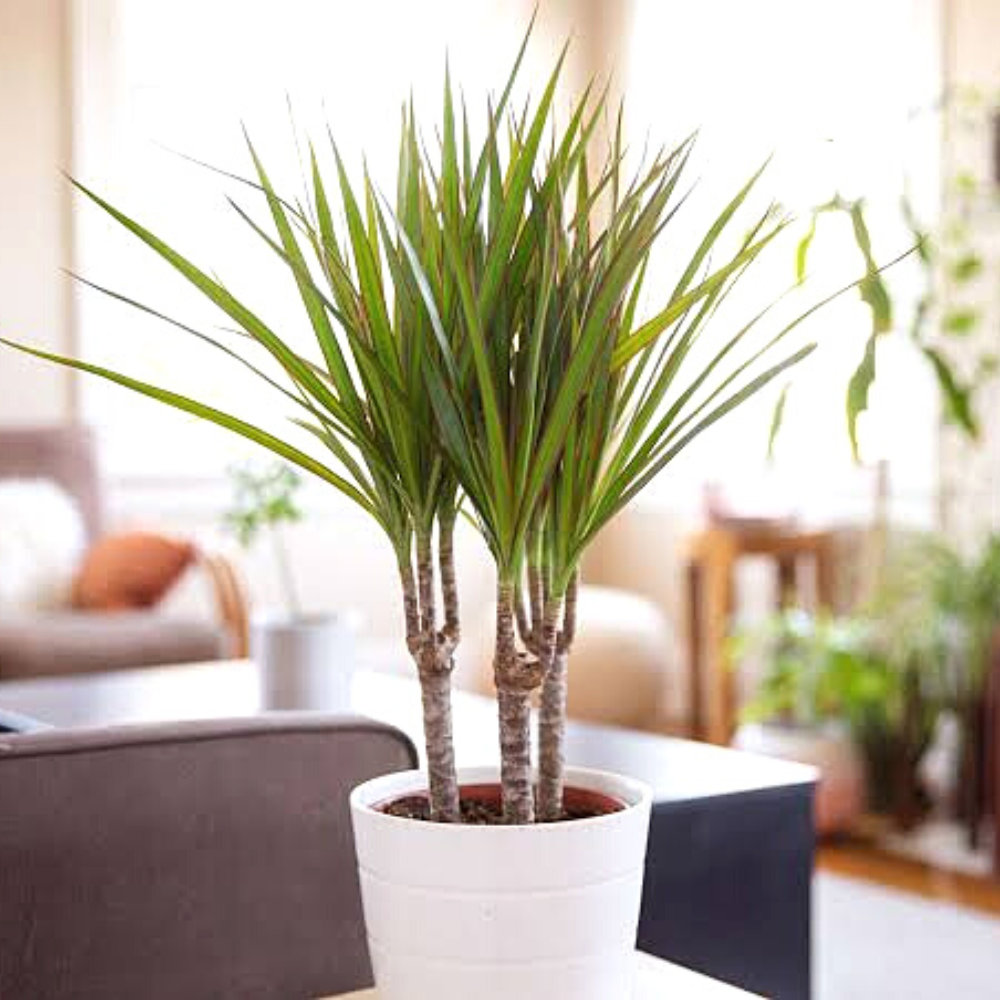
Having a unique appearance and growing in a variety of lighting conditions make dracaena great window plants. It is a good choice for a standalone plant near your window since it has long strappy leaves. Also, tables or windowsills can be adorned with dracaenas as a centerpiece.
14. Air Plant

One of the best things about Air plants is that they do not require soil to grow. There is a wide variety of species of these plants, with leaves of varying shapes, sizes, and colors. Moreover, the air plant thrives in well-ventilated areas such as windows, making it an ideal window plant.
15. Parlor palm

Place a parlor palm plant on your window for a tropical look and an elegant feel. With its glossy dark green leaves, parlor palm can add sophistication to your window. You can place them near your window as standalone plants.
Best window plant
1. Snake Plant
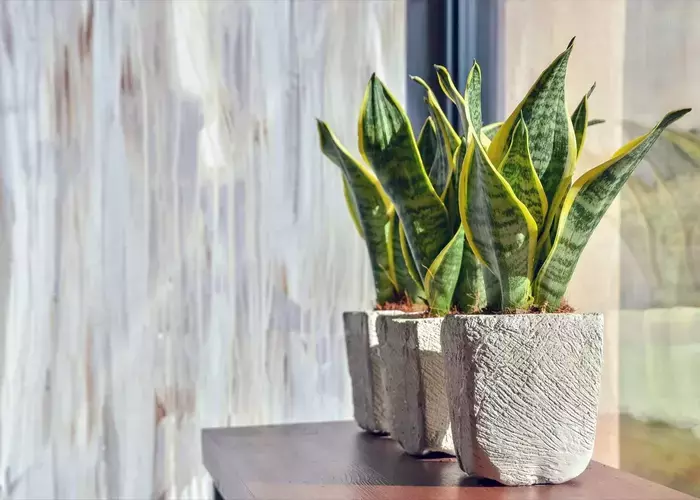
A popular feature of snake plants is their sword-like leaves. Its broad, thick leaves have an upright dark green color that’s variegated with white and yellow stripes. The best thing about snake plants is that they can survive in the most unsuitable growing conditions.
In terms of care, the snake plant is considered hardy and very easy to maintain. You can grow them both in full sun as well as in a low-light area of your house. However, indirect light is best. Snake plants are easy to root rot, so be careful not to overwater them. Let the soil dry out while you are watering.
An ideal location for snake plants would be 10 feet away from a west or south window. You can also grow snake plants in water. Moreover, the upright leaves look great in hanging baskets. Pet owners may also find a hanging basket a good option since snake plants are poisonous.
2. Spider Plant

There is a broad white stripe running along the center of the leaves of the spider plant. It is often displayed high or in a hanging basket in order to display the numerous plantlets and Spider Babies that develop on mature plants.
Make sure that this window plant receives bright to moderate light at a comfortable room temperature. It is best to keep the soil slightly moist. In spring and summer, water once a week; in winter, let the soil dry out a bit.
Window sills are also a good place to grow them, though be sure to keep them about 12 inches (30 cm) away from south-facing windows during the spring and summer months. It is also fine to place them in a north-facing window.
3. Pothos
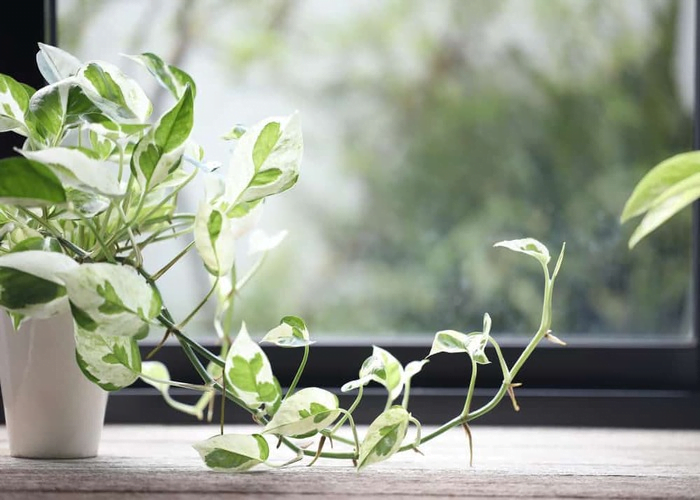
There’s a waxy, thick feel to the leaves on pothos, and the leaves look a little bumpy. Not only does this beautiful houseplant add a touch of green to any room, but it also purifies the air and reduces bad odors in the home.
You can find this plant indoors in many homes, offices, hospitals, and almost anywhere a plant is needed. When grown indoors, pothos prefers bright, indirect light. Also, it’s important for pothos plants to have their soil completely dry between waterings.
With low maintenance, this vine can grow anywhere. You can grow it as a house plant 5-10 feet in length, support it with a string or pole so it grows upwards, or plant it on a window or hanging basket if you want to see it dangling down stylishly.
4. Aloe vera

The shape and flesh of Aloe vera make it stand out from other plants. Aloe leaves are triangle-shaped, thick, and fleshy. The color can vary from light green to dark green.
You will absolutely love having the aloe vera plant on your windowsill since it loves bright, direct light. Aloe grows best on a south-facing windowsill, but west and east-facing windows will also work.
You won’t need to water it much just make sure it gets plenty of sunlight and water when the topsoil dries.
5. Money plant

Even in dry conditions, the money plant can survive without much attention. Its dark green, heart-shaped leaves make it different. Your interiors will look classic with the falling foliage of the plant on an uplifted stool.
One thing that makes money plants so adaptable is their ability to withstand different lighting conditions. It loves bright, indirect light and does best near north- or south-facing windows. Allow your Pothos to dry out between waterings, and water them about every two weeks.
6. Chinese Money Plant
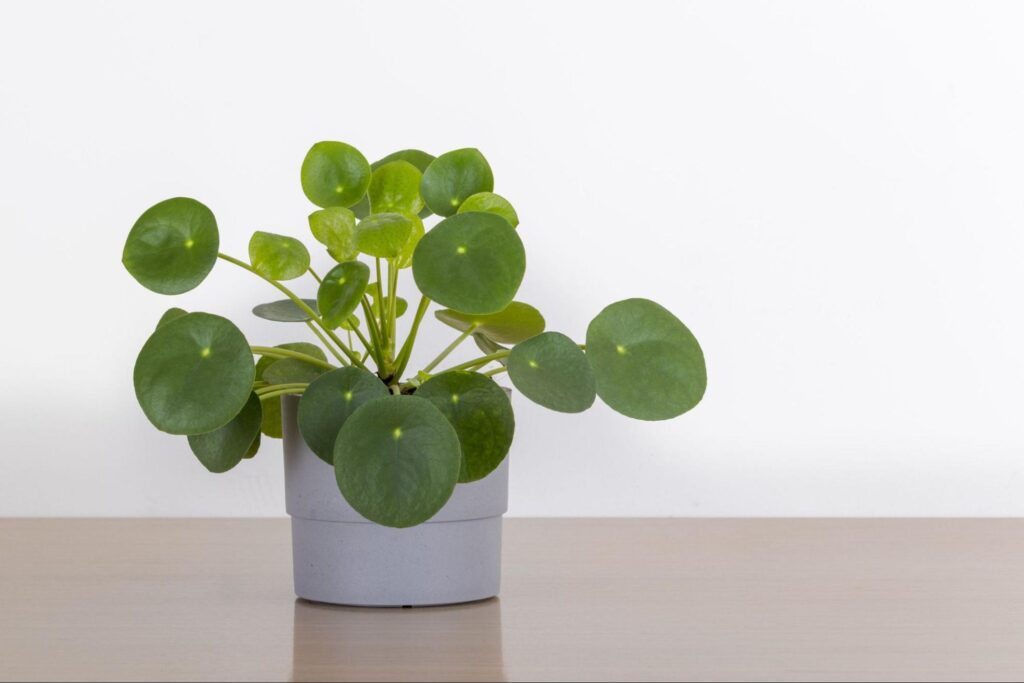
It is also known as the coin plant or Pilea peperomioides. The leaves of this plant are shiny and round, just like coins. It is because of this reason that these plants are believed to attract wealth and good fortune. Plus, it’s low maintenance and works best in medium light.
If you want your money plant to grow well, try keeping it in a partially sunny and partially shady spot. Place it close to a window in the southeast direction to remove any negative energy.
During summer, you can water your money plant every 7-10 days. In winter, water your plant twice a week.
7. ZZ plant
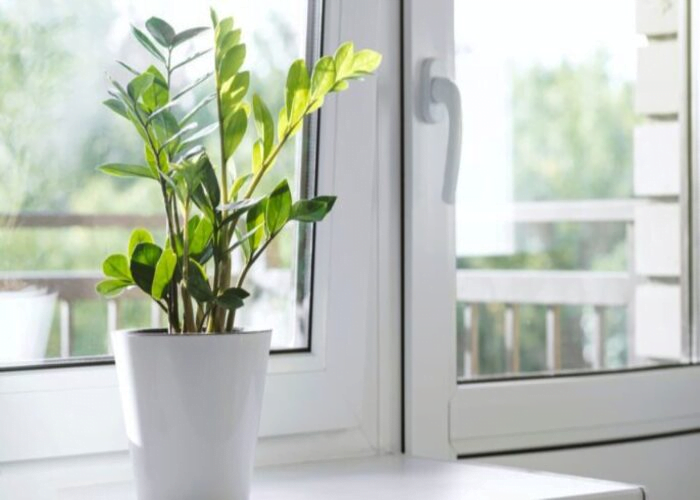
As the ZZ plant stem grows from a bulbous base to a point, it forms a graceful wand shape. There are fleshy, oval-shaped leaves along the stem, which give the plant the appearance of stylized feathers. Often, people mistake their leaves for artificial ones because they have a shiny, waxy coating.
Indirect light from north, east or west-facing windows is best for ZZ plants because they prefer low to bright indirect light. However, keep your leaves away from direct sunlight, this can scorch them. Water your ZZ Plant every 2-3 weeks, letting it dry between waterings. The brighter the light, the more often you should water.
Rooms with white or very light painted walls are good places to place ZZ Plants. In this way, you will be able to see the beautiful waxy leaves’ deep green tone instead of muted colors.
8. Ficus Benjamina
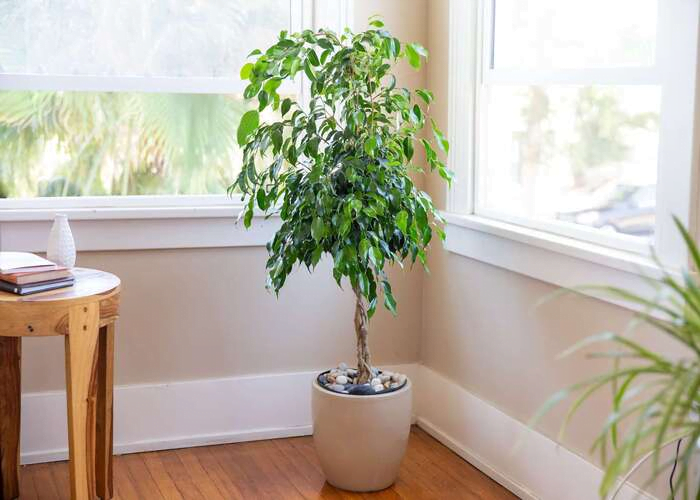
Ficus Benjamina also known as the weeping fig is an elegant-looking plant. The glossy, dark green leaves of Ficus Benjamina will add a touch of class to your windowsill.
Moreover, it is easy to care for this window plant just make sure to provide a well-lit area but away from direct sunlight. Also, water the plant regularly to keep the soil moisture consistent.
You can display Ficus Benjamina on the hanging basket to showcase its dropping leaves.
9. Succulent
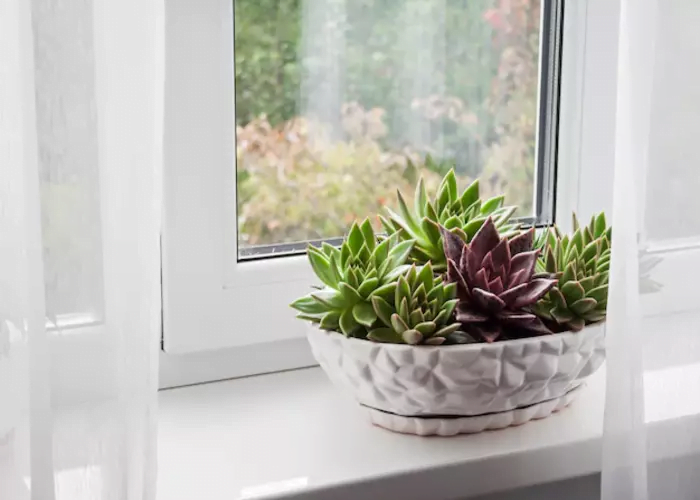
A succulent is an excellent choice if you live in a dry or sunny environment. Right from their shapes, sizes, and colors, succulent plants come in a wide variety.
Plants of this type require low maintenance. All they need is bright, indirect light and well-draining soil. Be sure that the soil has completely dried out before watering again.
Aloes, agaves, echeverias, and crassulas, all of which are low-growing and tolerate a range of light levels, are ideal for growing on windowsills. Almost all thrive in full sun and require very little watering.
10. Boston Fern

With its delicate fronds and lush green foliage, the Boston fern plant looks great on the window. Place them on a windowsill where they can enjoy bright, indirect light. Keep the soil consistently moist but not soggy.
You can group Boston ferns along with other plants, place them on a windowsill or hang them in a basket to showcase their cascading fronds.
11. Peperomia

This plant has silvery and green, striped, round, and pointed leaves that look like the rind of a watermelon.
Due to their preference for indirect light, peperomias thrive near east-facing windows or near or west-facing windows. These little beauties do well in rooms with north-facing windows, which have low light levels. It is also possible to grow peperomias under fluorescent lights.
Many plants in the Peperomia genus can look so distinct from one to the next that it’s hard to determine if they are even the same species. For instance, types like Peperomia obtusifolia are generally mistaken for rubber plants due to their identical appearance. All Peperomia plants need less care, are slow-growing, and can be grown all year long. Plus, they are believed to be clean-air plants.
Let the potting soil dry out between waterings every 1-2 weeks. In brighter light, water more often, in lower light, less often.
12. Calathea

Calathea also known as prayer plants are widely popular due to their striking foliage and unique leaf patterns. With their large, oval-shaped leaves and intricate markings they make a beautiful window plant.
To maintain the tricolor of leaves it is important to provide prayer plant bright, indirect light. Also, mist the plant and keep the soil moisture consistent. Additionally, it is important to keep them away from drafts or any other source of dry air.
These plants prefer a nicely-draining potting soil or blend. Look for components like compost, pine bark, coco coir, worm castings, and perlite. These deliver nutrients and help retain moisture, but deplete well.
The best way to enhance the appearance of your home is to showcase prayer plant leaves in the hanging basket.
13. Dracaena
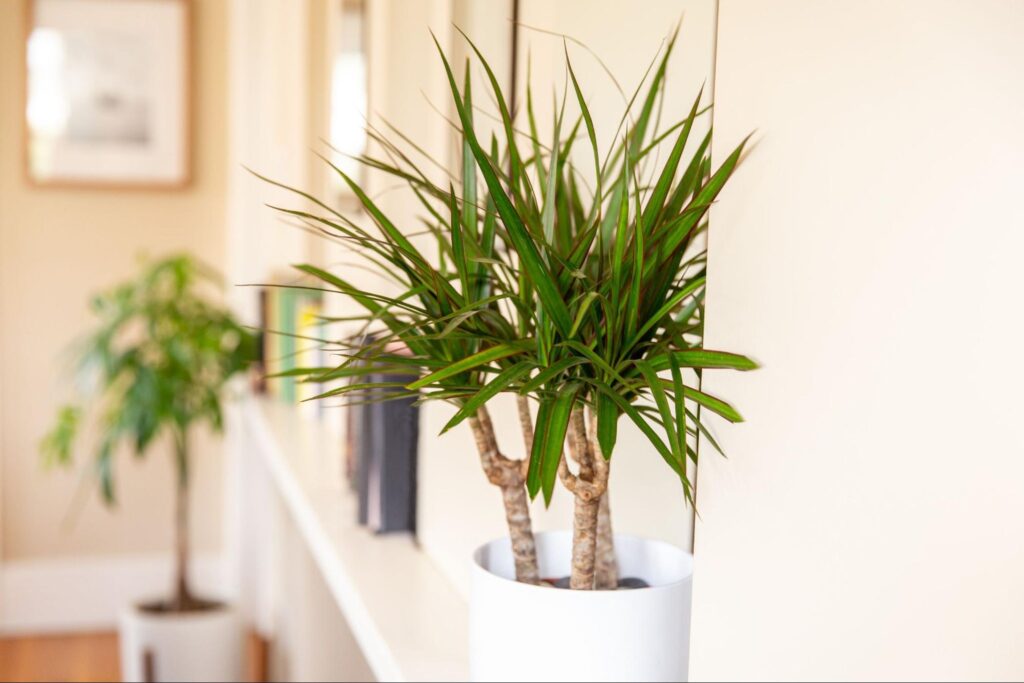
Dracaena plants have long strappy leaves that can be green, variegated, or even red-purple in color. This unique appearance of dracaena and its ability to thrive in a variety of lighting conditions make it a good choice as a window plant.
They prefer bright, indirect light, but also tolerate low-light conditions. Also, make sure to keep the soil consistently moist but not soggy. Additionally, avoid letting the soil dry out completely.
Dracaena with its long strappy leaves make a good standalone plant near your window. You can use dracaena as a centerpiece on a table or windowsill.
Root rot is a fungal infection that affects dracaenas that are overwatered and drives their leaves to turn yellow and wither or fall off. If this happens, discard and use new soil with more drainage substance.
14. Air Plant

The best thing about Air plants is that you can grow them without soil. These plants come in a wide variety of species, with different shapes, sizes, and colors of leaves. Some species have leaves that are green, while others are silver, purple, or even pink.
When it comes to caring for air plants, they require bright, indirect light and high humidity. They absorb moisture and nutrients through their leaves so they should be misted regularly or soaked in water for a few hours once a week. Additionally, the air plant would thrive in a well-ventilated area such as a window, making it an ideal plant for windows.
These plants can remove mild airborne pollutants and chemicals from your room. Plants can actually help you get over an illness like a cold quickly, since they purify airborne pollutants, like dust, from the air.
15. Parlor palm
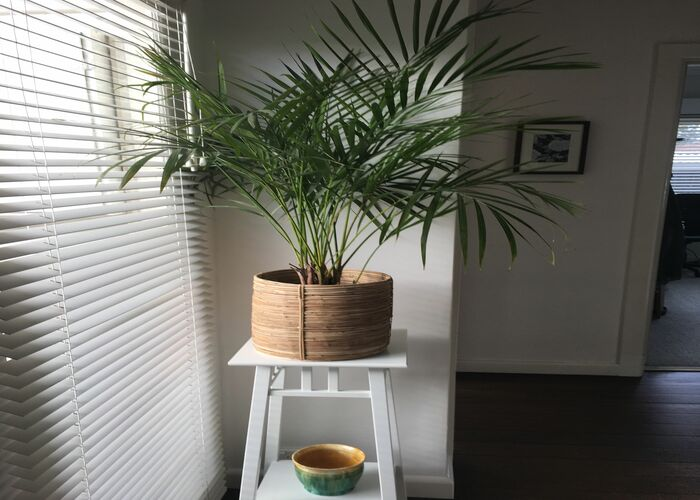
To give tropical vibes and an elegant look, place a parlor palm plant on your window. Parlor palm has a single thin trunk with feathery leaves that can reach up to 3 feet tall. You can add a touch of sophistication to your window with the glossy dark green leaves of parlor palm. Near your window, they make great standalone plants.
The parlor palm needs bright, indirect light and consistent moisture. Keep the soil consistently moist but not waterlogged and avoid letting the soil dry out completely. Give water to your palm plant from the top instead of the bottom, as they don’t like to sit in water for longer periods. They can survive for decades even in indoor environments.
FAQs
Q1. Which plant is good for bedroom windows?
Ans. The peace lily is a popular houseplant for bedrooms window because of its glossy leaves, which thrive in high or low light conditions, and its roots, which can tolerate a wide range of water conditions.
Q2. What plants like to be on the windowsill?
Ans. For those bright windows, Croton, Schefflera, Aloe vera, jade plants, and strings of pearls are perfect for bringing a hint of summer into your living space.
Q3. Should I put plants on the windowsill?
Ans. When it comes to plants, windowsills are prime real estate in your home. Additionally, they are out of the way yet still within sight, making them the perfect balance of brightness and visual appeal.
Q4. Should I move my houseplant away from the window in the winter?
Ans. Plants that are moved from window sills at night and kept away from heat sources, such as radiators, will have a better chance of surviving the winter months. You shouldn’t just watch out for windows, but also hotspots caused by your central heating.
Q5. How do I protect my plants in my window?
First of all, choose a window that has good natural light. It’s better to place small plants in the windowsill, if your windowsill is big enough to fit large plants, make sure the leaves are not constantly touching the glass.
Most plants are sensitive to cold weather, which is why we bring them indoors when the temperature drops drastically. But check if your window has any cracks, or else it will leak cold breezes through it. Seal the crack or if you can’t move it, save it from cold drafts.
In summer, the natural light coming from the window can be harsh as well, you will notice small burn spots all over the leaves in that case. Just use a sheer curtain to filter the light.
Q6. How do I keep my plants warm next to my window?
During winter the plants need to be warm just like us and to provide that you can just dress them up in bubble wrap. This method is cheap and boosts humidity in the dry winter. The temperature will always vary according to the temperature of the space they’re in but that added layer of bubbles will help protect against colder snaps.
Conclusion
If you are looking for a way to add a touch of green to your home, these 15 window plants are a great place to start. Whether it is an easy care plant such as a snake plant, spider plant, or money plant or a stunning piece of home decor such as a prayer plant, air plant, dracaena, etc., these plants surely make a great addition to any home.
To ensure that your window plant thrives, follow the care instructions mentioned in this article. Having your plants grow on a window means they get natural light, which is essential to their growth. In addition, plants are the best way to enhance the look of an empty windowsill. However, hanging window plants are the best option if you don’t have empty space on your windowsill.
If you are picking sun-loving plants, make sure to choose south windows. The southward direction gets a lot of sun. For bright indirect light, east or north is best.
Share this article with a friend or family member before you leave to help them select the right window plant. I would be happy to hear your thoughts about window plants in the comment section below.
Related Articles
- 15 Best Plants for Front Door Entrance India | Auspicious plants for front door
- 10+ Money plant Benefits That Will Make you Keep It In Your House
- Are Spider Plants Toxic to Cats?- 4 Ways To Prevent Your Cats From Eating Spider Plants.
- Best Plants for the House – 8 Top Apartment Plants That You Can’t Miss
- How to Braid Your Snake Plant: Tips and Care Guide
- 20+ Rare and Unusual Peace Lily Varieties You’ll Love






